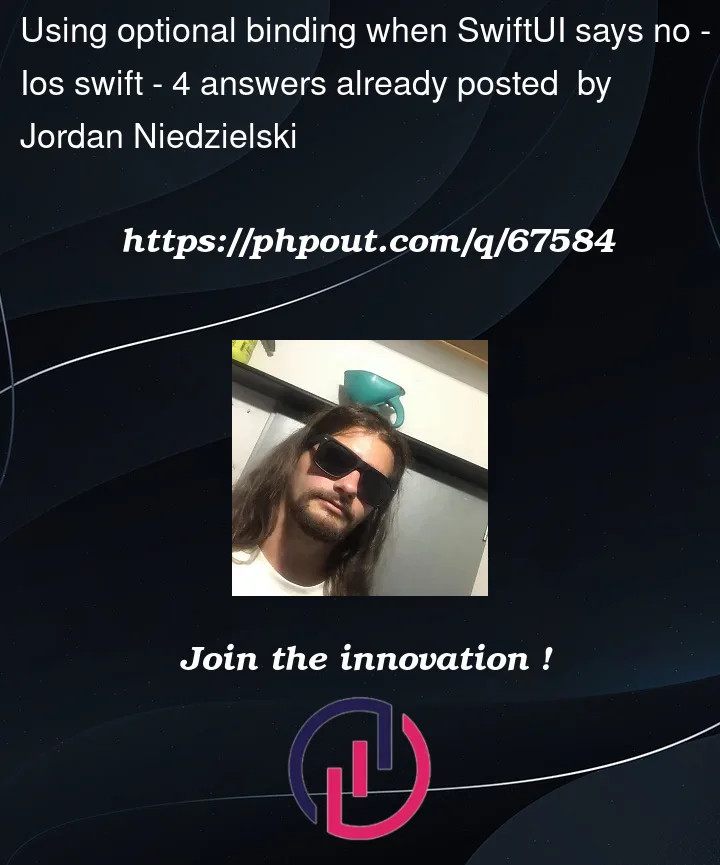The problem
TL;DR: A String I’m trying to bind to inside TextField is nested in an Optional type, therefore I cannot do that in a straightforward manner. I’ve tried various fixes listed below.
I’m a simple man and my use case is rather simple – I want to be able to use TextField to edit my object’s name.
The difficulty arises due to the fact that the object might not exist.
The code
Stripping the code bare, the code looks like this.
Please note that that the example View does not take Optional into account
model
struct Foo {
var name: String
}
extension Foo {
var sampleData: [Foo] = [
Foo(name: "Bar")
]
}
view
again, in the perfect world without Optionals it would look like this
struct Ashwagandha: View {
@StateObject var ashwagandhaVM = AshwagandhaVM()
var body: some View {
TextField("", text: $ashwagandhaVM.currentFoo.name)
}
}
view model
I’m purposely not unwrapping the optional, making the currentFoo: Foo?
class AshwagandhaVM: ObservableObject {
@Published var currentFoo: Foo?
init() {
self.currentFoo = Foo.sampleData.first
}
}
The trial and error
Below are the futile undertakings to make the TextField and Foo.name friends, with associated errors.
Optional chaining
The ‘Xcode fix’ way
TextField("", text: $ashwagandhaVM.currentFoo?.name)
gets into the cycle of fixes on adding/removing "?"/"!"
The desperate way
TextField("Change chatBot's name", text: $(ashwagandhaVM.currentFoo!.name)
"’$’ is not an identifier; use backticks to escape it"
Forced unwrapping
The dumb way
TextField("", text: $ashwagandhaVM.currentFoo!.name)
"Cannot force unwrap value of non-optional type ‘Binding<Foo?>’"
The smarter way
if let asparagus = ashwagandhaVM.currentFoo.name {
TextField("", text: $asparagus.name)
}
"Cannot find $asparagus in scope"
Workarounds
My new favorite quote’s way
No luck, as the String is nested inside an Optional; I just don’t think there should be so much hassle with editing a String.
The rationale behind it all
i.e. why this question might be irrelevant
I’m re-learning about the usage of MVVM, especially how to work with nested data types. I want to check how far I can get without writing an extra CRUD layer for every property in every ViewModel in my app. If you know any better way to achieve this, hit me up.




4
Answers
Folks in the question comments are giving good advice. Don’t do this: change your view model to provide a non-optional property to bind instead.
But… maybe you’re stuck with an optional property, and for some reason you just need to bind to it. In that case, you can create a
Bindingand unwrap by hand:That will let you bind to the text field. If the backing property is nil it will supply a default value. If the backing property changes, the view will re-render (as long as it’s a
@Publishedproperty of your@StateObjector@ObservedObject).There is a handy
Bindingconstructor that converts an optional binding to non-optional, use as follows:Also, MVVM in SwiftUI is a bad idea because the
Viewdata struct is better than a view model object.I think you should change approach, the control of saving should remain inside the model, in the view you should catch just the new name and intercept the save button coming from the user:
UPDATE
do it with whole struct
I’ve written a couple generic optional
Bindinghelpers to address cases like this. See this thread.It lets you do
if let unwrappedBinding = $optional.withUnwrappedValue {orTestView(optional: $optional.defaulting(to: someNonOptional).